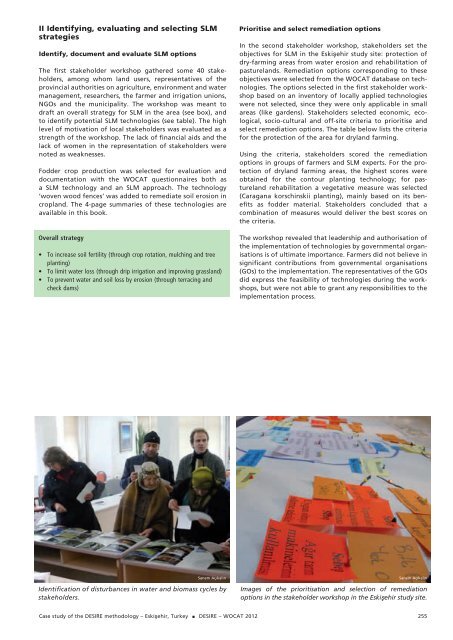Desire for Greener Land
Desire for Greener Land
Desire for Greener Land
You also want an ePaper? Increase the reach of your titles
YUMPU automatically turns print PDFs into web optimized ePapers that Google loves.
II Identifying, evaluating and selecting SLM<br />
strategies<br />
Identify, document and evaluate SLM options<br />
The first stakeholder workshop gathered some 40 stakeholders,<br />
among whom land users, representatives of the<br />
provincial authorities on agriculture, environment and water<br />
management, researchers, the farmer and irrigation unions,<br />
NGOs and the municipality. The workshop was meant to<br />
draft an overall strategy <strong>for</strong> SLM in the area (see box), and<br />
to identify potential SLM technologies (see table). The high<br />
level of motivation of local stakeholders was evaluated as a<br />
strength of the workshop. The lack of financial aids and the<br />
lack of women in the representation of stakeholders were<br />
noted as weaknesses.<br />
Fodder crop production was selected <strong>for</strong> evaluation and<br />
documentation with the WOCAT questionnaires both as<br />
a SLM technology and an SLM approach. The technology<br />
‘woven wood fences’ was added to remediate soil erosion in<br />
cropland. The 4-page summaries of these technologies are<br />
available in this book.<br />
Overall strategy<br />
• To increase soil fertility (through crop rotation, mulching and tree<br />
planting)<br />
• To limit water loss (through drip irrigation and improving grassland)<br />
• To prevent water and soil loss by erosion (through terracing and<br />
check dams)<br />
Sanem Açıkalın<br />
Identification of disturbances in water and biomass cycles by<br />
stakeholders.<br />
Case study of the DESIRE methodology – Eskişehir, Turkey DESIRE – WOCAT 2012<br />
Prioritise and select remediation options<br />
In the second stakeholder workshop, stakeholders set the<br />
objectives <strong>for</strong> SLM in the Eskişehir study site: protection of<br />
dry-farming areas from water erosion and rehabilitation of<br />
pasturelands. Remediation options corresponding to these<br />
objectives were selected from the WOCAT database on technologies.<br />
The options selected in the first stakeholder workshop<br />
based on an inventory of locally applied technologies<br />
were not selected, since they were only applicable in small<br />
areas (like gardens). Stakeholders selected economic, ecological,<br />
socio-cultural and off-site criteria to prioritise and<br />
select remediation options. The table below lists the criteria<br />
<strong>for</strong> the protection of the area <strong>for</strong> dryland farming.<br />
Using the criteria, stakeholders scored the remediation<br />
options in groups of farmers and SLM experts. For the protection<br />
of dryland farming areas, the highest scores were<br />
obtained <strong>for</strong> the contour planting technology; <strong>for</strong> pastureland<br />
rehabilitation a vegetative measure was selected<br />
(Caragana korschinskii planting), mainly based on its benefits<br />
as fodder material. Stakeholders concluded that a<br />
combination of measures would deliver the best scores on<br />
the criteria.<br />
The workshop revealed that leadership and authorisation of<br />
the implementation of technologies by governmental organisations<br />
is of ultimate importance. Farmers did not believe in<br />
significant contributions from governmental organisations<br />
(GOs) to the implementation. The representatives of the GOs<br />
did express the feasibility of technologies during the workshops,<br />
but were not able to grant any responsibilities to the<br />
implementation process.<br />
Sanem Açıkalın<br />
Images of the prioritisation and selection of remediation<br />
options in the stakeholder workshop in the Eskişehir study site.<br />
255









